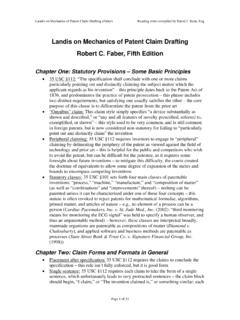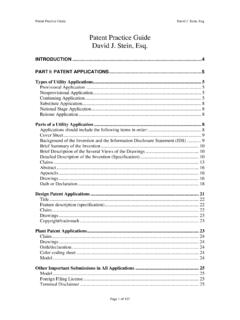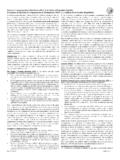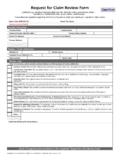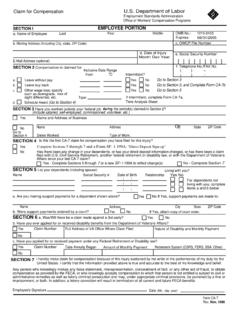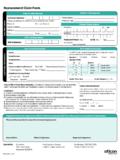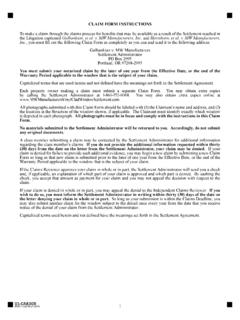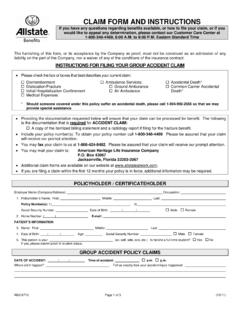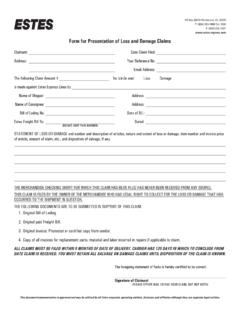Transcription of Landis on Mechanics of Patent Claim Drafting - …
1 Landis on Mechanics of Patent Claim Drafting (Faber) Reading notes compiled by David J. Stein, Esq. Landis on Mechanics of Patent Claim Drafting Robert C. Faber, Fifth Edition Chapter One: Statutory Provisions Some Basic Principles 35 USC 112: The specification shall conclude with one or more claims particularly pointing out and distinctly claiming the subject matter which the applicant regards as his invention this principle dates back to the Patent Act of 1836, and predominates the practice of Patent prosecution this phrase includes two distinct requirements, but satisfying one usually satisfies the other the core purpose of this clause is to differentiate the Patent from the prior art Omnibus Claim : This Claim style simply specifies a device substantially as shown and described, or any and all features of novelty prescribed, referred to, exemplified, or shown this style used to be very common, and is still common in foreign patents, but is now considered non-statutory for failing to particularly point out and distinctly Claim the invention Peripheral claiming.
2 35 USC 112 requires inventors to engage in peripheral . claiming by delineating the periphery of the Patent as viewed against the field of technology and prior art this is helpful for the public and competitors who wish to avoid the Patent , but can be difficult for the patentee, as it requires some foresight about future inventions to mitigate this difficulty, the courts created the doctrine of equivalents to allow some degree of expansion of the metes and bounds to encompass competing inventions Statutory classes: 35 USC 101 sets forth four main classes of patentable inventions: process, machine, manufacture, and composition of matter . (as well as combinations and improvements thereof) nothing can be patented unless it can be characterized under one of these four concepts this statute is often invoked to reject patents for mathematical formulae, algorithms, printed matter, and articles of nature , no element of a process can be a person (Cardiac Pacemakers, Inc.)
3 V. St. Jude Med., Inc. (2002): third monitoring means for monitoring the ECG signal was held to specify a human observer, and thus an unpatentable method) however, these classes are interpreted broadly, manmade organisms are patentable as compositions of matter (Diamond v. Chakrabarty), and applied software and business methods are patentable as processes (State Street Bank & Trust Co. v. Signature Financial Group, Inc. (1998)). Chapter Two: Claim Forms and Formats in General Placement after specification: 35 USC 112 requires the claims to conclude the specification this rule isn't fully enforced, but it is good form Single sentence: 35 USC 112 requires each Claim to take the form of a single sentence, which unfortunately leads to very protracted sentences the Claim block should begin, I Claim , or The invention claimed is, or something similar; each Page 1 of 32. Landis on Mechanics of Patent Claim Drafting (Faber) Reading notes compiled by David J.
4 Stein, Esq. Claim should also begin with a capital letter and end with a period ( A pencil having a fastener at one end. see Reckendorfer v. Faber (1875)) verb forms should also match throughout the Claim Numbering and order: In design and plant patents, only one Claim is permitted;. utility patents can and usually do have many claims patents with one Claim should not include numbers, but multiple claims should be numbered consecutively MPEP (m): claims should be ordered with the broadest Claim first, and similar claims should be grouped together (a Patent claiming both a process and its product should group the claims to each concept); a horizontal line can be used to separate different groups of claims Numbering during prosecution: When a Claim is canceled in prosecution, its number is not reused, and the others are not renumbered claims added during prosecution are appended to the Claim set, and are given the next highest number when the Patent issues, the USPTO renumbers all claims to produce a consecutive set if a continuation Patent application is filed, the claims in the original Patent should be logically renumbered Preamble: Every Claim should have an introductory section called a preamble.
5 Indicating the statutory class of the invention and describing it as a whole . shorter preambles are preferred (Karsten Mfg. Corp. v. Cleveland Golf Co. (2001): an improved correlated set of iron-type golf-clubs preamble was construed to use correlated as a Claim limitation). Preamble scope: The preamble should be consistent with the scope of the actual Claim , and should be revised if the Claim scope is modified the title of the invention should be similar to the preambles of the claims, but can vary as needed, since the title cannot be read as a Claim limitation an overly broad scope ( an apparatus comprising ) is poor form it's important that the preamble match the invention described in the specification: if the specification calls for a bicycle, the Claim should not specify vehicle ; similarly, if the invention is useful on bicycles or motorcycles, the Claim should not specify bicycle . Preamble limitations: The preamble should not include unnecessary limitations; if a limitation is necessary for the Claim to be patentable, it should be included in the body of the Claim , perhaps in a whereby clause but if the limitation is needed to put the rest of the Claim in proper and understandable context, it can be featured in the preamble composition of matter claims that describe a new and unnamed material may need to include several preamble limitations just to describe it, or may include it as a whereby clause ( a composition having density w and color x, comprising materials y and z ; a composition comprising materials y and z, whereby the composition has density w and color x ) preambles with additional nouns may make the transition ambiguous ( apparatus for shaking articles comprising do the following limitations apply to the apparatus or the articles?)
6 ; this can be clarified by re-specifying the class ( apparatus for shaking articles, the apparatus comprising ). Preambles in dependent claims: A dependent Claim implicitly, if not explicitly, includes the text of the parent Claim it's incorrect to specify an invention in a dependent Claim that is broader in any aspect than its parent Claim (a Claim to an apparatus for shaking articles should not be referenced by a dependent Claim to Page 2 of 32. Landis on Mechanics of Patent Claim Drafting (Faber) Reading notes compiled by David J. Stein, Esq. an apparatus for holding articles during shaking ; if each aspect is important, Claim them with separate independent claims) more commonly, the dependent just recites the statutory class ( the apparatus of Claim 1, further comprising ). Jepson Claim preamble: A Jepson Claim describes the prior art, before specifying an improvement to it Jepson Claim preambles are usually quite long, and the descriptors of the prior art are always considered limitations and relevant to the scope of the Claim , so accuracy is important USPTO use of preamble: The USPTO relies on the preamble to triage the application to an appropriate examining group, so crafting the claims with this goal in mind is helpful Preamble as Claim limitation: Precedent is split as to whether preambles limit the claims the general rule is that the preamble is a limitation if it breathes life and meaning into the Claim (MPEP ), and is not a limitation if it simply states the intended use or purpose of the invention ( Bard, Inc.)
7 V. M3 Sys., Inc. (1998)). Preambles found to be Claim limitations: Invention producing on a photoreceptor an image of generated shapes made up of dots was held to be functionally interwoven with the Claim body, and thus a limitation (Pitney Bowes, Inc. v. Hewlett-Packard Co. (1999)) also, detailed description in the preamble of the structure of a Claim element used in a method process was found to be a limitation (Eaton Corp. v. Rockwell Int'l Corp. (2003)) where the preamble characterizes the invention as a method of treating or preventing a condition, and the Claim body references a human in need thereof, the preamble is functionally tied to the Claim body and breathes life and meaning into it, thereby rendering it a limitation (Jansen v. Rexall Sundown, Inc. (2003)) similarly, if a Claim recites a method of diagnosing a particular condition, it cannot be effectively used without this goal in mind and would be an empty exercise, and thus is a limitation (Griffin v.
8 Bertina (2002)). Preambles found not to be Claim limitations: Preamble recites a communication system but this term does not appear in the body of the Claim , and is not a limitation (NTP, Inc. v. Research in Motion Ltd. (2002)) similarly, a method for reducing hematologic toxicity in a cancer patient merely describes how the invention might be used, but the method can be infringed by application in other contexts; thus, reducing portion not a limitation (Bristol-Myers Squibb Co. v. Ben Venue Labs, Inc. (2001)); contrast with Griffin above, where a specific diagnostic purpose was required where the preamble simply suggests using it in one context ( located at predesignated sites such as consumer stores ), but the method can be similarly utilized in other contexts, the Claim is not a limitation (Cataloina Mktg. Int'l, Inc. v. , Inc. (2002)) where the preamble describes features necessarily involved in an invention, but the Claim does not depend on or mention those features, it is not a limitation (Schumer v.
9 Laboratory Computer Systems, Inc. (2003)) finally, if the Claim body recites a structurally complete invention that does not need the preamble language for support, the preamble is not limiting (Intirtool v. Texar Corp. (2004)). CAFC guidelines for identifying limiting language: In resolving this ambiguity of precedent, the CAFC specified five cases where preamble language is limiting: Page 3 of 32. Landis on Mechanics of Patent Claim Drafting (Faber) Reading notes compiled by David J. Stein, Esq. Jepson Claim preambles; Claim body reliance on the preamble language for antecedent basis; preamble needed to understand elements in the Claim body;. specification emphasizing additional elements as important; and apparent use of the preamble to avoid prior art examples of prior art avoidance: Claim to E. coli cells modified to E. coli cells of improved competence during prosecution;. CAFC held this as necessary to avoid prior art, and therefore limiting, even though the body of the Claim was unchanged similarly, addition of rich in glucosinolates considered limitation for avoiding prior art Transition term: The word between the preamble and the Claim body materially affects the Claim two most common transition terms: comprising and consisting of these terms may be used to describe sub-elements in a Claim , and are similarly interpreted in that context Transition term comprising : This term means including the following elements but not excluding others ; this is an open transition term, allowing, , a method Claim to cover infringing methods that include additional steps.
10 Synonyms: including, having, containing, and even wherein ; but these other terms may be construed as less open than comprising (Lampi Corp. v. Am. Power Prods., Inc. (2000)) if many of the elements comprising an invention share a common characteristic, a competing embodiment may infringe even though not all of the elements share that characteristic (Texas Instruments, Inc. v. Int'l Trade Comm'n (1993)). Consisting of : This term means including the following elements, no more and no less (MPEP ) synonyms: composed of, constituting, and being while presumptively closed, these terms may be open-ended if so described in the specification a composition consisting of certain elements may contain trace amounts of other non-functional elements, but no more than that however, a competing product may still infringe if it adds an element that is non-functional; , a Claim to a chemistry kit consisting of certain elements but not specifying a spatula encompasses a kit that does include the spatula, because the spatula is not a functional part of the invention (Norian Corp.)
